

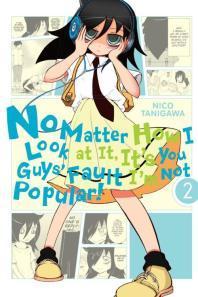
The manga industry over in the US has some hardworking people that…the average fan may or may not know about. They may not even know how valuable they can be when it comes to working on a manga series. So, I’m working on projects involving people in the industry. You can expect the next project sometime in March. For now, I’ll start with letterers!
Well, what exactly is a letterer? In simple terms, they’re the ones who add the dialogue, the sound effects, and the signs in a manga. They’re also the ones who make sure a manga feels about as natural and easy to read as possible. I asked 4 questions to letterers working in the industry, and working for companies like Viz Media, Yen Press, and Crunchyroll — you may be surprised by their answers.
How did you get the opportunity to start working as a manga letterer?
Annaliese Christman (Tegami Bachi, World Trigger): I was a design intern at Viz one summer. I was helping out with the creation of a special “Shonen Jump Issue #0″ magazine and was asked to letter a couple color Naruto pages. I did so and had a lot of fun, so I asked around to see if there was a way I could do it as a job, and was given a test to take. Guess I did well enough on the test, because a couple months later I started work on my first series!
DMG Letterer #1: I’m a former scanlator. DMG got my career start. I do DMG part time now and I work for DMP (their imprint) lettering. They keep me busy. I’m happy with this job. I get to work from home. I occasionally letter for a foreign manga publisher.
Abby Lehrke (Translator/Letterer of A Town Where You Live on Crunchyroll, Letterer of My Grandpa’s Stories Can’t Be This Weird, Can’t Ride a Bicycle, more on MangaBox): Well, I started work as a letterer because I was a translator. I got the job translating and from the sample on I was asked to provide my own lettering. I think I’ve only done one project that I didn’t letter, and it led to more work which I do. I don’t mind, because I’ve been a comic artist for a lot of years and I learned all the lettering lessons I needed to.
Sabrina Heep (Claymore, NANA, The Story of Saiunkoku, Voice Over! Seiyu Academy): I began studying Japanese on my own, for fun, during art school. A few years later I was translating a manga I wanted to read and truly understand–one not available in English. (And still isn’t, actually.) I decided to letter the manga and share the pages with my friends, who were also interested in it. After I’d finished the first volume, a friend of mine saw a job listing at Viz.com for manga letterers and told me about it. I applied, and a few months later I was officially working in the field. My dream job! Note I don’t translate professionally, I letter. But being able to read Japanese has been incredibly helpful in my job.
DMG Letterer #2: I’m a scanlator. I still am. But I letter for several publishers in the US now — part time.
Lys Blakeslee (WATAMOTE, Durarara!!, Thermae Romae): Though I’ve been a fan of manga for a long time, I never thought to work in the manga industry (but now that I’m here I love it). I graduated from university with an Art/Illustration degree and my first freelance jobs were children’s book illustrations. In late 2009, a couple years after graduation, a friend from my Japanese language class (I’d taken two years in university for fun) contacted me about lettering for the publisher she worked for. She’d gotten an internship with them that turned into a position as an editor. The publisher was in need of letterers just then, and my friend, knowing my art background and interest in Japanese media, thought of me. So (with much glee and excitement and wonder: “Is this real life?!”), I took their lettering test, and I’ve been putting words on manga pages ever since!
Melanie (Piece of Love x Love Sickness, The Conqueror’s Chalice): My roommate signed up for DMG. I did too, and we are on the same team.
April Brown (Atomcat, Triton of the Sea, Unico): I owe my start to three people, Scott O. Brown, David Gallaher, & Jody Lehup. I was new at lettering, I am talking fresh out of college kinda new, I knew nothing. David and Jody were my first two editors. I think I had to revise my first book about eleven times. Like I said I was new at it. But with their help and patience I grew and so did my confidence in lettering. And Scott was there for me when I needed advice on things or how to do it. Honestly, my first job really comes down to having the right timing. I am very thankful for those three, probably more than they will ever know.
I have come a long way from when I started lettering manga. Since then I have started my own publishing company, Bronco Ink Publishing, LLC., in which I do most of the lettering for the print and digital. So far the only project that I have not lettered since starting my company is Krantz, which we are now doing a kickstarter for limited edition projects to help get the word out.
Kameron (DMG Letterer): A friend is a letterer for a publisher. He referred me.
Allen (DMG Letterer): I have a friend who works for a publishing company. She told me about the position.
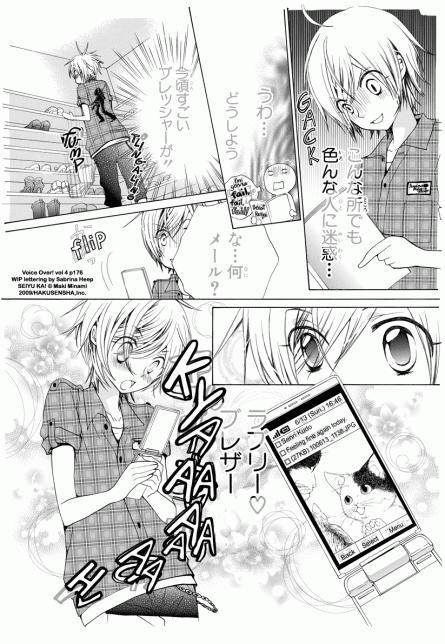
Unfinished Voice Over Academy page
If there was one misconception you had about the manga industry before you started working in the industry, what was it?
Annaliese: I didn’t understand how many of the industry professionals are enormous manga fans who truly love series they work on. A lot of my friends and I would get so mad at changes made to series we enjoyed and rant about how people working on it CLEARLY did not care about manga. It only took one day of being an intern to see how completely wrong I was. Hahaha, it’s pretty embarrassing to think back to that.
DMG Letterer #1:None, actually. As a scanlator, I knew what’s involved. The industry is so small – the opportunity is extremely limited. I think you really have to have a connection – like, know the editor in chief.. or know someone at the office. I am grateful for Digital Manga Inc for this opportunity.
Abby: I don’t know, really. When I started working on translation it was after the manga bubble burst. I’ve been an avid observer of trends in comics all over the place because of my interest, so when I actually got the chance to go in for a job it was pretty obvious to me where things were going. I think my biggest misconception as a translator was that I would be given any input by the artist/writer or the client company as to what direction they wanted for specific phrases. I thought I’d be given a set list of things to refer to, but it turned out I was the one who had to make the list. It was daunting at first.
As a letterer, I think a lot of times people don’t realize that some projects will ask you to touch out the Japanese lettering yourself. I have a couple of clients who have me do that, and of course you always need to be able to touch out some text if the artist wrote it by hand on the originals so that there’s room to put the English text down. It’s something I didn’t realize that even pros have to do sometimes.
Sabrina: When I started, I suspected that the editors didn’t really care about manga. I thought they all just wanted a fat profit margin. And while every business needs to keep profit in mind, my various bosses really DO care about manga. They genuinely want to remain as true to the original as they can, and respectful of a mangaka’s creation, and want the books to look as good as possible. They’re limited by public expectations, content laws, printing budgets, and the official style handed down from on high, but the editors really do try. Complete original faithfulness is always where they begin.
DMG Letterer #2: That “anyone can do lettering” < — YOU CAN’T! it’s a difficult process. It’s mundane. It can be boring.
That this kind of job is easy. It’s NOT.
That this kind of job is everywhere. It’s NOT.
Lys: It’s hard to recall any major misconceptions. Even before I started working in the industry, I’d gotten to know a few other professionals online, and read about their experiences with much fascination. I guess I didn’t really have a good sense of how much time and work is involved in the localization process from start to finished book, with all the different tasks, and people to do them, that need to be lined up: translation, lettering, editing, printing…never mind the whole contract/licensing process with the Japanese publishers, which is still entirely a mystery to me.
Specific to lettering, I didn’t know anything about how artwork was delivered to the North American publisher from the Japanese side: scans of the printed book? Flattened page layouts as they were sent to the Japanese printer? Clean layouts with the text removed? I discovered this can vary from one series (or even volume of a series) to another, but in recent years with newer titles, it’s becoming more common to get clean artwork with text either on a separate layer or already removed, which saves a lot of time retouching the artwork. My very first series was done from scanned pages, and it had a TON of text overlapping the artwork, frequently with a layer or two of screentone patterns to be matched up and replaced. It was a good learning experience, and definitely helped prepare me for some of the challenging projects to come.
Melanie: I’m new to this whole industry, so I am unaware of what’s going on. But lettering is tougher than you think.
April: The only exposure to manga I had before lettering was in cartoons and what ever books my boyfriend at the time was showing me. Growing up I was more interested in theater and sports than in reading books. I didn’t start reading manga until my first project, which I have I to say was a great fit for me. But my favorite one I have read so far is again a book I lettered, Unico by Osamu Tezuka. I love the stories and the art, it was a great pleasure working on it.
Kameron: My friend told me that it’s a fun job. Its actually not. It’s dull and boring.
Allen: That lettering is easy. There is no such thing as a “easy job”
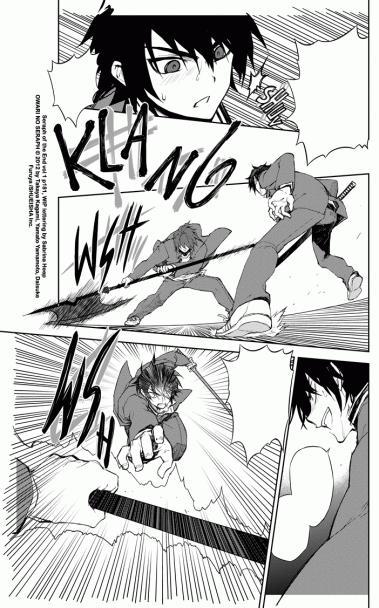
Unfinished page of Seraph of The End
What’s the worst thing you had ever done when it came to lettering?
Annaliese: I won’t say what series it was in, but the worst mistake I think I’ve made was missing a HUGE sound effect before a book went to print. My editor and I didn’t notice it at all. I just happened to be flipping through it when the book was released and stop on the page to see a large katakana “GO” right there, taking up at least a third of a page. It blended into the background really well, so hopefully few people have noticed.
The worst series I’ve worked on…my immediate answer would be Ultimate Muscle. It was the first series I worked on and it rubbed me the wrong way. There was a huge learning curve, I was still in college, I didn’t care for the subject matter…it was really stressful and I ended up really hating the series for a long time. Over time it became such a regular part of my life, I was really upset when I turned in the final volume. Now there are other series that might take the crown of “the worst,” but none of those would be because they are bad titles, it’s more the various forms of stress associated with them.
Abby: A thing I really commonly hate is when the artist makes the dialog bubbles just wide enough to fit only the Japanese text horizontally. I really hem and haw over those panels. If it’s just one word, and a short one, I sometimes do just set it vertically, but usually I have to hyphenate almost all the words and make the text really small to make stuff like that fit. It’s pretty common with 4-panel comics, because of the limited panel size.
Sabrina: I’ve had a number of truly horrific pages to tackle, but one that sticks in my mind was a character popularity poll in Skip Beat!. This was years before the text-free versions of manga pages were available, and so I had to letter the pages as they appeared in the Japanese graphic novel, with the characters’ names and number of votes covering the artwork. I squished and stretched and hyphenated and rotated and placed fat white strokes around the English as much as I could, to save me from as much Japanese touch-up as I could, but those three pages still took an entire day for me to finish–particularly the last one. I considered flipping through all of Skip‘s previous volumes and finding each character image used in the last poll page so I could paste in the not-obscured art, but that would have taken even longer than just doing it the hard way. You can see the poll in Skip Beat! volume 17 at the beginning of chapter 100.
Lys: I do most of my lettering work with InDesign, which lets me lay out the page artwork and create text style settings to use consistently from page to page. The one disadvantage I found it to have compared to working with text in Photoshop is that the text is vector-based and can’t simply be erased to fit an area or cut off at the edge of a panel. For a long time, in that situation I would import the text to Photoshop and rasterize and manipulate it from there. But this back-and-forth could be time consuming and tedious with my slow (hard-working!) computer, so I wanted to find a way to do everything in InDesign. A big motivator for figuring this out was starting on my first series that required replacing the Japanese sfx with English: it involved a lot more artsy text-manipulation than most of my lettering work. I searched the internet for InDesign tips and found a way to mask a shape or an area of the text so it wouldn’t show up. It worked perfectly for my purpose, and I used my newfound knowledge on a few other projects and thought I was just the cleverest of letterers.
Well. A few months later, I got early complementary copies of the first three books in which I’d used the text-masking technique, and to my absolute horror, the text I had masked in InDesign showed up in full on the printed page, running over into the margin and the other panels. It was a mess! It was all wrong! It was the end of the wooooorld!! I immediately told my editor and we tried to figure out what was wrong, how widespread the damage was, how it might be fixed in for these and future… it was intense. My editor is awesome, and she told me it wasn’t my fault that this new InDesign technique didn’t work right with their printing service, but I still felt responsible for it, and upset that something I’d worked really hard to make as perfect as I could had gotten so messy and imperfect. And what would the fans think of such sloppy work?! I was really sad about it for some time. Fortunately, since I had noticed the problem promptly, we were able to track down where I’d used the technique in other not-yet-printed books and fix those (by importing the text to Photoshop and doing things the old way) before anything else was affected. The three books that went to print with the error were popular enough that they have since been reprinted with the pages fixed. And I stick to using Photoshop for any fancy text-hiding tricks, and try not to get carried away with my pride.
Melanie: I was running late on my project, I asked my brother to help me letter 1/2 of the book. And I took all the credit for it.
April: Now this is a loaded question. If you are talking the worst project I have ever work on, there is none. Sure there have been projects that are not my taste or style but that does not take away from the story or the art. Now if you are talking about my biggest mistake I have ever made. I would have to say that would have been formatting a book. I kept getting the settings wrong but that was years ago. I learned my lesson on that and double check everything now.
Kameron: I missed the deadline so I lied about a family emergency to get a few extra days to finish the project.
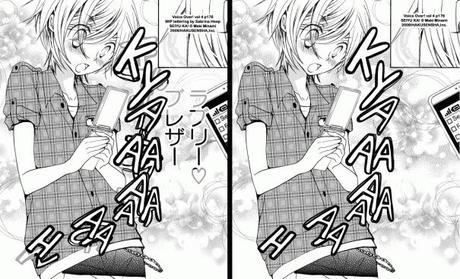
Voice Over! Seiyu Academy unfinished to finished
What type of advice would you give to someone who might be interested in this venture?
Annaliese: Have a lot of patience and really love manga!
DMG Letterer #1: Get experience. Lots and lots of experience. You apply as a letterer the first thing anyone will ask you is “so, who have you worked for? What kind of experience do you have? Which book have you lettered?” Being able to say “a DMG title” — my works are on Amazon and Nook – it’s easier to get a job.
Abby: Phew, I don’t know. I’ve never gotten just lettering work, I’ve always lettered stuff I also translated. But one thing I know is important whether you’re translating or lettering or both is to be quick. Recently, I’ve taken to doing several passes over each page, I’ll typeset the sound effects (which usually use a different font) on all the pages, then go back to 1 and typeset the dialog. It makes things faster and more efficient when I’m not going back and forth between a bunch of different fonts. If I have to switch a bunch of fonts in one page it tends to make me really irritable, too. I take longer breaks between pages, and groan and complain more, ha ha. So that’s one of the strategies I’ve really found useful recently. It also means that you can just copy over sound effects that already have stroke on the text, so that you don’t constantly have to restroke the same 10px of white around everything you’re writing. I used to have to stroke by hand, that was a nightmare. Anyhow! That’s really the best advice I can give. Also, just like anything, there’s no getting work unless you have a body of work to show off.
Sabrina: I have three pieces of advice: First, learn to read Japanese. In truth, most letterers CAN’T read a single kana of Japanese, but I have found it so helpful in my work, particularly on crazy comedy titles with fifty different things happening on one page, like Skip Beat, Honey & Clover, and Voice Over!. I’ve also noticed missing lines from the translation, and can get those taken care of immediately. Second, learn at least the basics of Photoshop and InDesign. Even now that we have access to the type-free pages for so many titles, you still need Photoshop to do FX and retouch, to clean up random specs or scanned hairs that ended marring the original artwork file, and things like background signs or handwriting. InDesign is the industry standard for typesetting and layout these days. The program isn’t very intuitive, and it would definitely be better to have experience using it BEFORE being thrown in the deep end with a book deadline, like I was! Third, be capable of working alone. If you can’t focus on one thing for hours, if you can’t stand not having IRL coworkers to talk with, if you can’t meet deadlines without a boss breathing down your neck, you’d probably be better of doing something else. Or lettering manga in an office setting.
DMG Letterer #2: Know how to use photoshop like – a professional! Have a fast GRAPHICS computer. Have a fast internet connection!
Lys: In my experience with both freelance manga lettering and book illustration, connections with other people are of huge importance, both for learning about what the work is like and for getting in touch with publishers and work opportunities. It’s hard to predict what connection might turn into something… and I never went after friends to get me a job: the opportunities arose naturally out of my acquaintance with them.
As for technical advice, familiarize yourself with Photoshop and InDesign. I use the latter for both page layout and adding text to the pages. A couple publishers may still have their letterers add the text in Photoshop, but in my experience InDesign is a lot easier to work with and most publishers seem to be heading in that direction. Knowing Japanese isn’t a requirement for lettering, but it certainly makes it easier for me to figure out which bubble gets which line of text, in cases where the script isn’t clear or the panel layout is confusing.
Melanie: Advice…? None that I can think of…but I wish I knew Japanese and I can translate. Lettering is the most time-consuming part of the manga localization. I think lettering should be paid the most. then the translator, then the editor – in that order.
April: If you want to be a letterer you need to get out there and just do it. There is no magic wand to wave to make it happen. Hard work and not giving up. And do research on who is printing what. Make the editors know your name, submit samples and keep working at it.
Kameron: Know your Photoshop and Illustrator.
Allen: Publishing industry is a very very small industry. All upper managements and company seniors – they know each other and they “talk.” Never bad mouth about a competition or competitors. They’ll find out and it’ll eventually come back and bite you in your rear end!
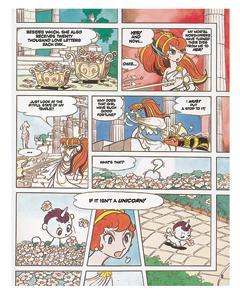
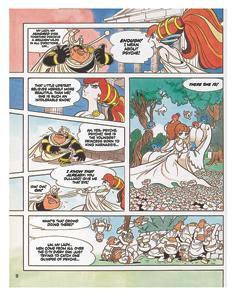
Finished pages of Unico.
So, What’s Next?
I hope that this can be the start of a few more projects talking to industry people, so be on the lookout for that in the next few weeks. For now, a big thanks to the letterers who participated in it. Otherwise, if anyone has any questions, feel free to ask in the comments.

